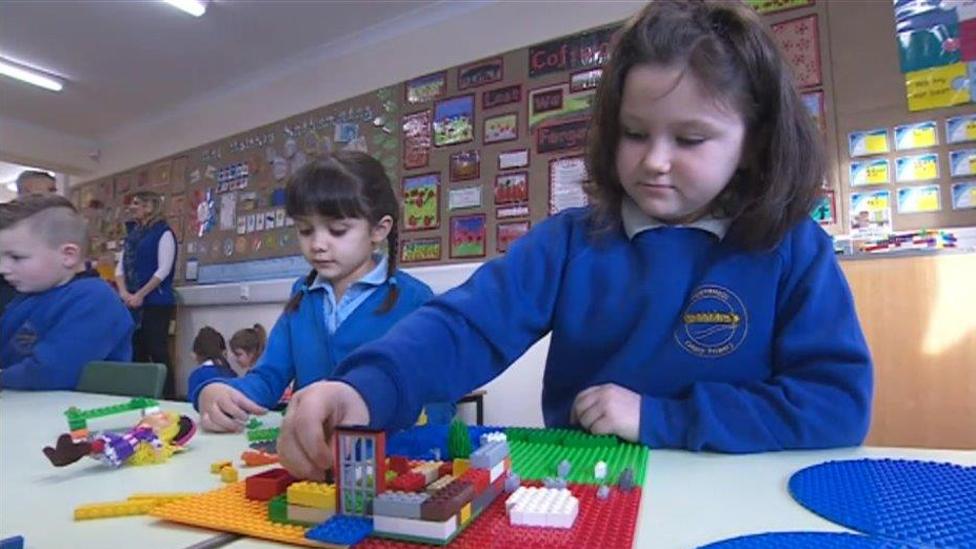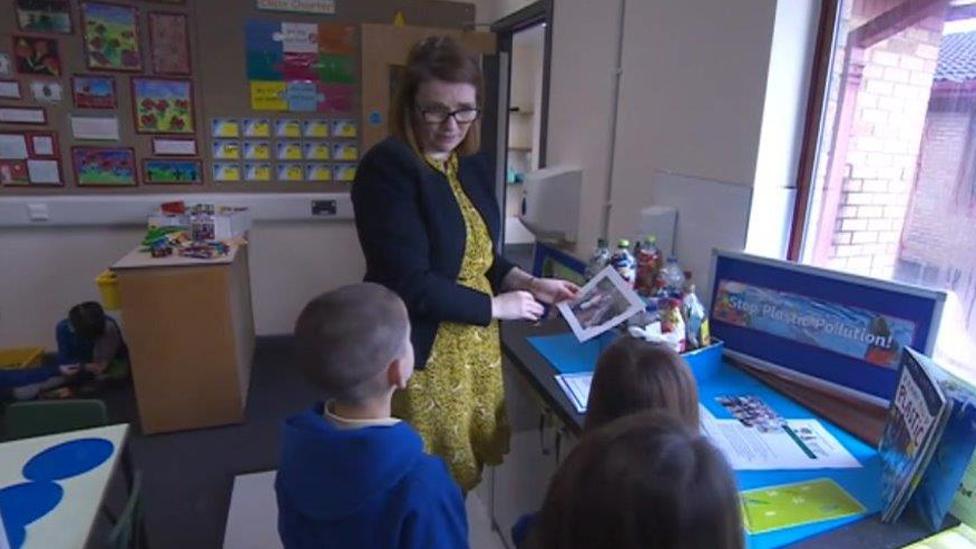Teachers worry over funding for smaller classes in Wales
- Published
- comments

Penyrheol Primary in Swansea is one of the schools to benefit - with the head saying it led to a more nurturing environment
Most schools in Wales that appointed new teachers to cut infant class sizes say they will not be able to keep them when a government grant ends.
A progress report by Education Minister Kirsty Williams on a flagship policy, which began in 2017, said 115 schools were benefiting from the £36m fund.
Under the scheme, grants pay for new school staff or extra classrooms for four to seven-year-olds.
Some education experts and politicians have questioned its value for money.
The Welsh Government said it was targeting the money at schools with significant numbers of poorer pupils, higher levels of children with additional learning needs or with English as an additional language, or where outcomes were lower than average.
It aims to spend £16m to fund 150 additional teaching staff and £20m to create 59 new classrooms as well as improving existing facilities.
So far, 95 additional teachers and 40 additional teaching assistants are in place.
But the report said the majority of schools that have received a grant to fund additional teachers said they would not be able to keep them when the grant ends in August 2021.
"Schools are reporting that budgets are becoming more challenging each year and maintaining the additional teachers would put them in a deficit budget," it said.
A "very small number" of schools said they would look at using the Pupil Development Grant or carefully managing budgets to keep the classes.
Examples of how the grant has been used include creating two classes of about 15 from one class of 30, or creating smaller classes of about 10 for those pupils who need extra support.
A commitment to reduce infant classes was a key element of the agreement which brought Liberal Democrat Kirsty Williams into the Labour cabinet in 2016.
But some politicians and advisers questioned at the time whether the millions allocated to the policy would be better spent on other priorities.

What do the figures on class sizes tell us?
Across Wales the average infant class size was down slightly in 2019 to 25.4 pupils from 25.6 in the previous two years.
Latest figures show 7.2% of infants are in classes of 31 or more pupils - the lowest proportion for five years.
But there has been an increase in average class sizes amongst the juniors - pupils aged seven to 11 - up from 25.9 to 26.3, with more than 15% of junior pupils in classes of 31 or larger.

Kirsty Williams met pupils and teachers in Swansea
Ms Williams, on a visit to Penyrheol Primary School in Swansea, said additional time spent with teachers is making a "massive difference" to pupils.
"I've spoken to the head teacher here this morning who said it's had a profound effect on the ability to raise standards of pupils as well as improve the conditions for teachers, giving them the time and space to do their job," she said.
There are no infant classes with more than 30 pupils and one class has only 17 pupils. The school has also had money to help build an extra classroom and an all-weather outdoor learning area for the foundation phase.
Head teacher Alison Williams added: "It's enabled all children to feel they have a voice within their class - they tell us it's lovely, they can hear the teacher.
"Smaller classes are more nurturing and enable staff to intervene at critical times during learning."
The government said its approach to cutting class sizes was based on international evidence.
'Wide agreement'
However, the Organisation for Economic Cooperation and Development (OECD) has said the overall evidence on the effects of reduced class size on student performance is "weak".
It has said cutting class sizes results in "trade-offs", which could mean less investment in other key areas.
But it said there was "wide agreement" that younger children need more time and interaction with teachers and "some evidence" that smaller classes may benefit students from disadvantaged backgrounds. , external
Plaid Cymru education spokeswoman Sian Gwenllian welcomed the emphasis on reducing class sizes so that more time could be devoted to individual pupils.
"However, major problems still face our schools and our teachers - including the fact that we lose a third of new teachers within the first five years and that we are not recruiting as many new teachers as we should be," she said.
"We need urgent measures to turn this situation around. Otherwise there won't be enough teachers in the system to allow class sizes to reduce in future years."
Suzy Davies, who speaks on education for the Welsh Conservatives, said: "Any commitment has to be clear on how to attract enough teachers and support staff with the necessary skills."
- Published8 March 2018

- Published1 June 2016

- Published23 January 2017
